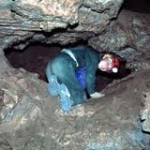The Wonderful World of Caving
You gain strength, courage and confidence by every experience in which you really stop to look fear in the face. Eleanor Roosevelt
One’s sense of adventure can bring the desire to do many outlandish things like bungee jumping or skydiving. An unusual experience is exploring a cave. You have not seen darkness until you turn off your headlamp and experience total blackness, quite amazing. If you find yourself with the insatiable desire to explore the world below we offer these suggestions.
Be prepared to be safe: Wear a helmet while caving to protect your head. Wear a headlamp on the helmet and bring several extra sources of light. If you don’t produce the light there will be no light, and the expedition suddenly becomes extremely difficult and hazardous. As always, with any trip, bring your first aid kit, food, multi-tool and water.
Don’t go alone: Bring a friend or small group increases both the safety and overall enjoyment of the activity, especially if you have never done it before. If an emergency situation presents itself, a group of people will be able to get things under control, go get help, administer first aid, or even avoid an emergency altogether. If something happens on your own, there is no one to help. It also helps to let someone know where you are going and when you expect to be back.
Wear appropriate clothes: Remember that caves are typically wet places due to water percolating down from the surface. They are also rather chilly, at a constant 55° F. Many people favor jumpsuits typically worn by automotive workers because they are tough, reliable, and relatively warm. Others will wear light, long sleeves and layer rain gear over it to stay dry. Once a set of clothes has been in one cave, it should not ever go into another cave because of a highly transferable fungus that destroys bat populations. Cavers spread the mold by using the same clothes in different caves. Fishing gloves are handy because of the sealed palms; they keep the hands dry and warm especially when grabbing wet stone.
Navigate Carefully: Bringing a map of the cave is extremely useful for navigation; however they can be difficult to read since the 2D map is showing a 3D tunnel system. Most well explored caves are rather hard to get lost.
Leave No Trace: Protecting sensitive cave resources is very important because they can be easily ruined. Making a concerted effort to remove trash makes not only your visit more rewarding, but improves the experience of others in the future. It is common to see arrows marked on the walls of a cave, but arrows are not naturally occurring, so it is good practice to refrain from marking walls.
If you are interested in trying out spelunking, consider hiring a reputable outfitter. To learn about Terrapin Adventures Intro to Caving tour, click here.
Jeremy Biedzynski, Assistant Manager, Guide, Terrapin Adventures.

